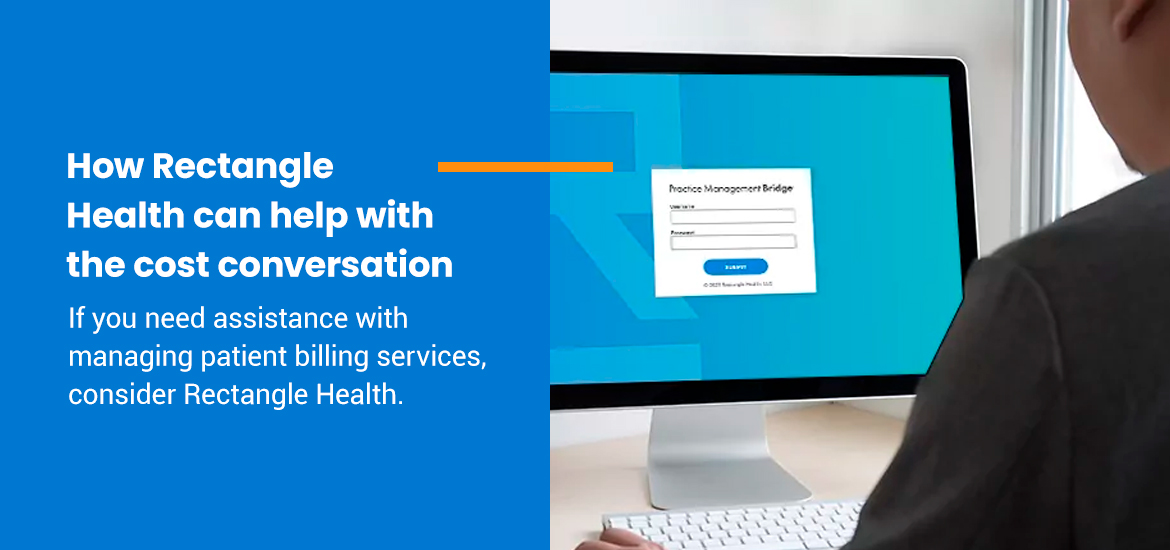Patients have to manage many healthcare costs. From travel expenses to lab costs to insurance fees, receiving healthcare treatments can be costly. And to make matters worse, payment processes are often confusing and complicated. It’s often challenging to understand how much patients owe when factoring in healthcare systems, Medicare, and other coverage options. Patients also face additional copays, insurance premiums and other out-of-pocket costs. For those without medical insurance, it can be even more overwhelming to understand their bills and how they will afford the costs.
The variations in payment and coverage options make it important to use transparency when discussing fees with patients. Healthcare professionals should strive to give in-depth explanations of prices and services. Providing sufficient information about price breakdown builds trust with patients and sets expectations for future visits. It could prepare them for future bills and reduce late fees in the long term.
Read on for more information about price transparency in healthcare.
Why Annual Physicals Are Not Always Fully Covered
Clarifying healthcare services is essential for price transparency. One of the confusing price points of healthcare concerns the difference between physicals and wellness visits. Both of these visits are yearly check-ups used for ongoing health maintenance. However, the two visits have some key differences separating them:
- Wellness visits: Wellness check-ups focus on preventative care. Healthcare professionals record key measurements like height, weight, and blood pressure. They also perform brief screenings for mental illness. You discuss current medications, any changes in your medical history, and future goals for wellbeing. Medicare completely covers yearly wellness visits, meaning users don’t have to pay additional copays for the appointment.
- Physical exams: During a physical, a doctor or other healthcare professional examines your body for potential health problems. They assess risk factors, such as family medical history. Then, doctors complete a series of physical tests on areas like your abdominals, neurological areas, and lungs. Overall, a physical test inspects your physical body for abnormalities or other health problems. Medicare does not cover annual physicals unless the additional tests are also part of your coverage plan.
Despite their differences, the two visits are similar, and sometimes their terms are used interchangeably, adding to the overall patient confusion. This confusion can lead to complications in payments.
For example, patients might request a physical exam because they think Medicare covers it. Afterward, they receive a bill for the services they cannot afford. The bill will add to their bewilderment about healthcare costs, especially if they cannot find an explanation after the appointment.
What Is Not Covered In an Annual Physical
The confusion between a wellness visit and a physical exam is an example of the lack of transparency in healthcare pricing. Patients should be fully aware of prices for typical tests and operations. They can then discuss payment coverage with their insurance provider or prepare another way to pay.
By understanding what is covered in specific visits and treatments, patients can better prepare for future bills. The more prepared patients are, the less likely they will halt or decline treatment. For example, these are usually included in wellness visits without extra payments:
- Weight, height, and blood pressure measurements
- Discussion of health goals or changes with doctors
- Screening for cognitive or mental issues
However, these are not covered by an annual wellness check-up:
- Sick visits: If you visit the doctor for a specific illness and they prescribe a treatment plan or antibiotics, these services are not considered part of a wellness visit. Depending on your insurance plan, you might be billed a copay after your appointment.
- Chronic illness treatments: Additionally, care for chronic illness is not normally included in yearly visits. This exclusion means you cannot discuss or give treatment for illnesses like diabetes, high blood pressure, or high cholesterol during an annual check-up. If you provide services for chronic illness during a wellness check, a patient will face an additional bill afterward.
Keeping patients informed about annual wellness visit coverage helps with price transparency.
Other Hidden Healthcare Costs for Patients
Patients often face other hidden healthcare fees that deter them from seeking care. Many of these services aren’t upfront about total costs, making patients unable to afford expenses. The overwhelming variety of fees might cause users to stop asking for medical care altogether, which has dangerous consequences on our society’s health and the healthcare system.
In addition to copays, healthcare payers face expenses like:
- Physician costs
- Dental costs
- Insurance premiums
- Hospital services
- Prescription costs and subscriptions
- Long-term home care
- Treatments for long-term illness
Without payment transparency, these prices might become unmanageable for patients. If they can’t keep track of their overall healthcare expenses, they could fail to set aside sufficient funds for payment.

Transparency is Key for Patient Retention
It’s crucial to keep healthcare accessible for all people. However, the rising costs of health services and other factors prevent many patients from accessing it readily.
Healthcare professionals should strive for cost transparency in their practices. Unexpected fees cause patients to feel frustrated and distrustful toward their healthcare practitioners. Using price transparency builds trust with your patients and increases the chance they’ll return for your services later.
Maintaining patient retention assists with a practice’s success. The stronger bond you have with your patients, the more rewarding the experience becomes. Show your patients you care by providing detailed accounts of costs and price breakdowns.
How to Explain Costs and Annual Physicals to Patients
Medical professionals should carefully approach discussions of costs with patients. They should be honest and upfront about service fees. Doctors could ask about financial situations or worries about payments, creating an empathetic connection. Talking about costs openly reduces fear and encourages a way to find solutions.
For example, clarify the difference between annual physicals and wellness visits. Use charts or infographics to clearly differentiate services and how much they will cost with or without insurance. Ensure that all employees are well-versed in costs and can answer any questions.
You could also implement solutions like automated payments. These can help patients pay faster and give them a full explanation of their bills.
By offering explanations and open discussions, patients can better understand their healthcare expenses. They will also trust your services more and will likely return for future appointments. Lastly, the price and quality transparency can help more patients access healthcare services and improve revenue cycle management.

How Rectangle Health Can Help with the Cost Conversation
If you need assistance with managing patient billing services, consider Rectangle Health. Rectangle Health is a leader in healthcare technology, providing software solutions for hospitals, dental practices, and other specialty locations. By streamlining your payment processes and updating technology systems, you can improve efficiency and price transparency for patients.
Our Practice Management Bridge® software can improve your efficiency and enhance the patient experience. From payment solutions to communication capabilities, our software helps in a variety of ways. You can easily integrate our platform with your current technology to get started in no time.
In addition to patient billing services, Practice Management Bridge® features:
- Customizable messaging: With our customizable messaging system, you can message patients directly. Keep them updated on upcoming appointments, billing notifications, and other updates. You can communicate costs upfront to minimize confusion about billing.
- Patient financing: Provide more payment options for your patients with our financing solutions. From payment plans to third-party financing, you can give your patients other ways to finance their healthcare.
- Streamlined payments: Practice Management Bridge® offers many payment options that can simplify patient bills. Patients can choose online payments, text-to-pay services or other options. Our variety of payment solutions allows patients to select one that makes them feel the most comfortable.
- Digital registration: We also offer digital registration forms so patients can fill out information before their appointment time. This option reduces time spent on forms during appointments, which can increase office efficiency.
To get started with Rectangle Health and our healthcare solutions, request a demo.
References
- Beaufort Memorial. (2020, Sept. 11). Is It an Annual Physical or Wellness Exam? https://www.bmhsc.org/blog/is-it-an-annual-physical-or-wellness-exam.
- https://www.medicare.gov/. Yearly “Wellness” visits. U.S. Centers for Medicare and Medicaid Services. https://www.medicare.gov/coverage/yearly-wellness-visits.
- Medicare.org. Does Medicare Cover Annual Physicals? https://www.medicare.org/articles/does-medicare-cover-annual-physicals/.



